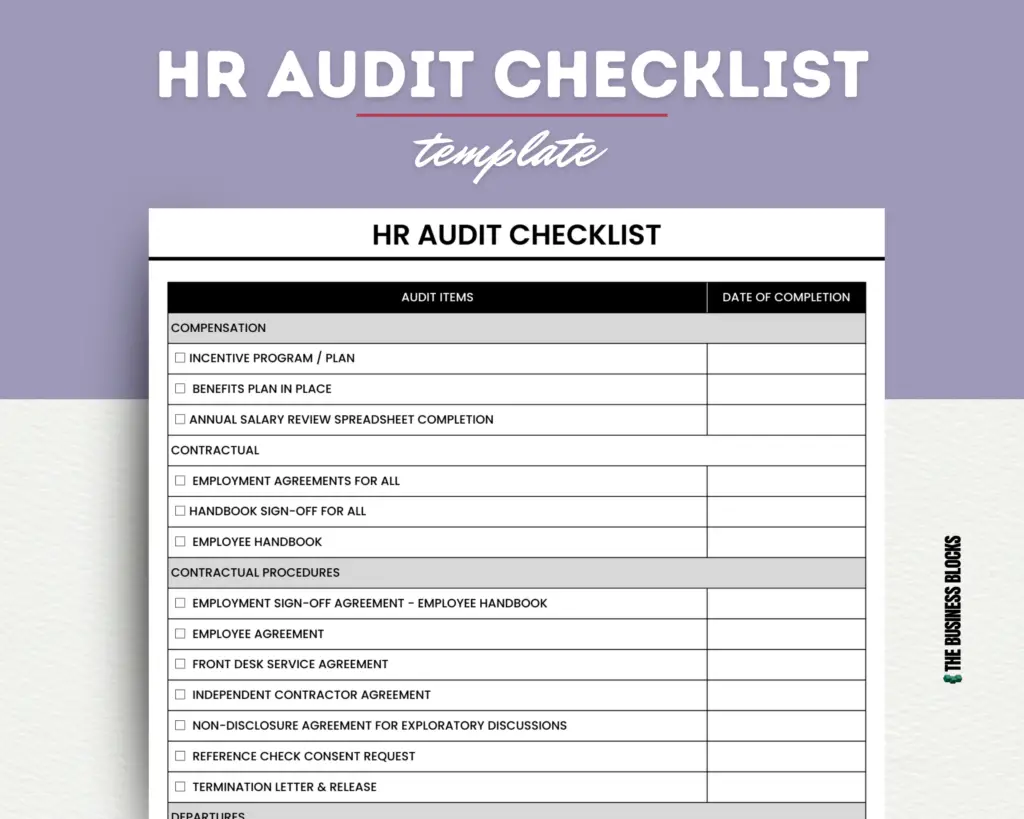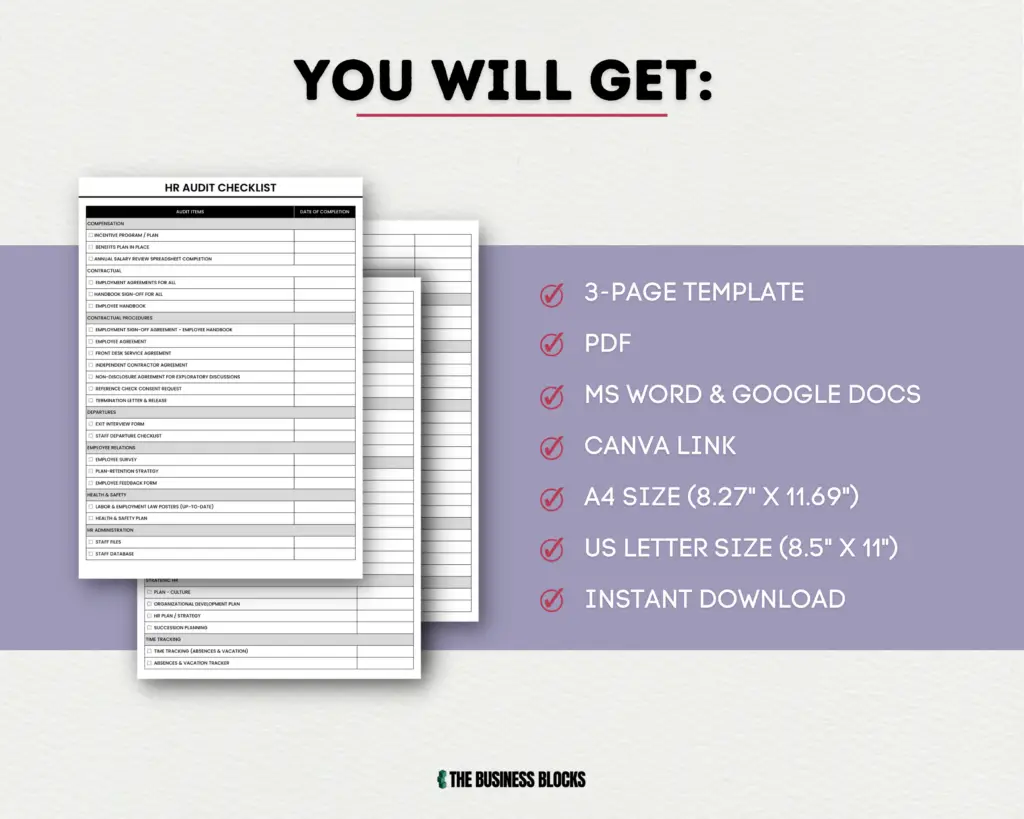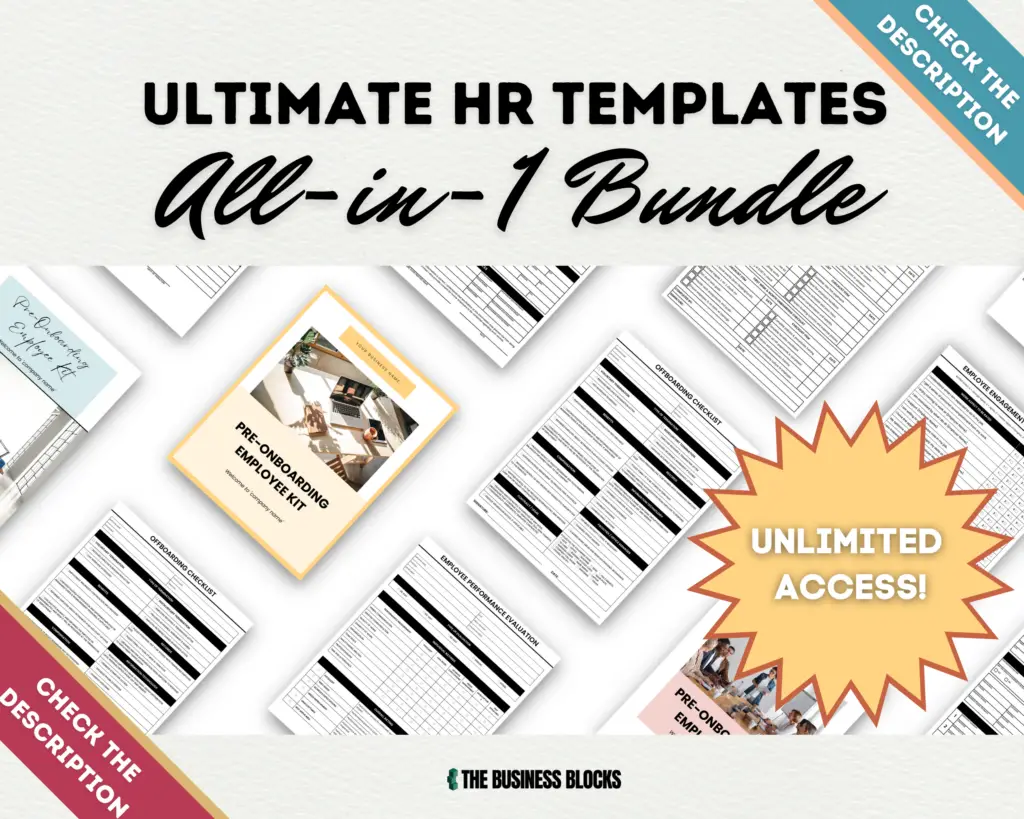HR audit Checklist Template is a tool used by Human Resources professionals to ensure that their organization complies with all applicable laws, regulations, and standards. The HR audit Checklist Template can be used to inventory and assess current policies, procedures, and practices; identify areas of compliance risk; and develop an action plan for addressing identified issues.
The checklist may also collect relevant data on organizational performance and best practices in human resource management. Let us discuss the value of an HR audit checklist and provide a customizable template that will help streamline your HR review processes and save time.
Ensure your employees get fair opinions on their work performance – read on for more information about our comprehensive HR audit checklist template!
Are you Responsible for Managing your Company’s Human Resources?
An HR Audit Checklist Template is an invaluable tool for keeping up with the ever-evolving responsibilities of a human resources department. It will keep track of documents received and tasks and processes completed and provide valuable insight into any areas that may need additional compliance or review.
With this template at your fingertips, you can ensure all aspects of your HR organization comply with current laws and regulations. It will help identify improvements needed to keep the department running efficiently while minimizing organizational risk. And best of all, it will save you time by providing instant access to information when needed most!
What is HR Audit Checklist?
An HR Audit Checklist is a tool HR departments use to review and assess their current HR policies, procedures, and practices. The checklist typically includes questions or items to review, such as job descriptions, employee files, benefits administration, and compliance with labor laws and regulations.
An HR Audit Checklist aims to identify areas where HR practices may be lacking or could be improved and to ensure that the company complies with relevant laws and regulations. By conducting regular HR audits, companies can identify and address potential issues before they become major problems and ensure that their HR practices are aligned with the company’s goals and values.
The HR Audit Checklist can be customized based on the specific needs and goals of the company. It can be conducted internally by the HR department or by an external consultant. The audit results can be used to develop an action plan to address any areas of concern and improve overall HR performance and compliance.
10 Key Areas to Include in an HR Audit Checklist
- Recruitment and Hiring: Review job descriptions, recruiting practices, hiring processes, and documentation to ensure compliance with labor laws and regulations.
- Employee Files: Review employee files to ensure completeness, accuracy, and confidentiality of personnel information.
- Compensation and Benefits: Review compensation and benefits policies and practices to ensure compliance with laws and regulations, and to ensure that the company is competitive in the market.
- Performance Management: Review performance management processes to ensure that they are effective in providing feedback, setting goals, and improving performance.
- Training and Development: Review training and development programs to ensure that they are aligned with the company’s goals and that they provide employees with the skills and knowledge needed to succeed.
- Workplace Policies and Procedures: Review workplace policies and procedures to ensure that they are up-to-date, compliant with laws and regulations, and consistent with the company’s culture and values.
- Employee Relations: Review employee relations practices, including communication, conflict resolution, and disciplinary procedures, to ensure that they are fair, consistent, and effective.
- Compliance with Labor Laws and Regulations: Review compliance with labor laws and regulations, including wage and hour laws, discrimination laws, and workplace safety regulations.
- Diversity, Equity, and Inclusion: Review diversity, equity, and inclusion policies and practices to ensure that they are aligned with the company’s values and goals and that they promote a diverse and inclusive workplace.
- HR Technology: Review HR technology systems and processes to ensure that they are up-to-date, efficient, and aligned with the company’s needs and goals.
By including these key areas in your HR Audit Checklist, you can ensure that your HR practices are effective, compliant, and aligned with your company’s goals and values.
Looking for an HR Audit Checklist template?
A good HR Audit Checklist template is essential for organizations looking to ensure compliance with legal requirements and best practices in human resources management. The checklist covers a wide range of HR areas, including employment policies, recruitment, training, benefits, and employee relations.
By using the checklist, organizations can identify areas of non-compliance or risk and take corrective action to mitigate potential issues. Moreover, a well-designed HR Audit Checklist can help organizations improve their HR practices and processes, leading to increased efficiency, effectiveness, and employee satisfaction.
This template is a terrific tool for any business because it’s not only simple to use but also polished.
You may quickly modify the template to match your unique demands and specifications because it is fully editable in Canva, Google Docs or Microsoft Word.


WHAT’S INCLUDED?
- Your Live Canva Document for Editing in 2 sizes US Letter (8.5″x11″) and A4 Size (8.27″ x 11.69″)
- Two Editable Google Doc Templates (US Letter and A4 Size), convertible to:
- Two Editable Microsoft Word Templates (US Letter and A4 Size), convertible to:
- Two Printable Adobe PDF Templates (US Letter and A4 Size)
REQUIREMENTS
- Google Account (for Google Docs templates)
- Microsoft Word (2007 or greater) for Windows or MacOS
- Canva Account (for Canva templates)
- Adobe Acrobat Reader
OTHER INFORMATION
To alter or modify these templates, some familiarity with Canva, Google Docs, or Microsoft Word is required.
No printed materials or physical products will be provided to you; this is a digital product.
The Business Blocks owns the rights of its designs. You may use the template as often as you like, but you may not share it with anybody outside of your business. Please get in touch if you need assistance with repairing or amending.
There are no returns because of the nature of the product, but we’d be happy to work with you to resolve any problems.

All-in-One HR Templates Bundle
With over 50 templates covering various aspects of HR, including recruitment, performance evaluation, employee benefits, and more, this All-in-One HR templates bundle provides everything needed to streamline HR operations and maintain compliance.
Why is the HR Audit Checklist important for your business?
An HR Audit Checklist is important for businesses for several reasons:
- Identify and Address Issues: An HR Audit Checklist can help identify potential issues and areas for improvement within your HR practices. By addressing these issues, you can improve the effectiveness and efficiency of your HR department, as well as ensure compliance with relevant laws and regulations.
- Ensure Compliance: An HR Audit Checklist can help ensure that your company is in compliance with labor laws and regulations. This can help mitigate legal and financial risks, as well as improve the overall reputation of your company.
- Improve Employee Engagement: By reviewing HR practices and addressing potential issues, you can improve employee engagement and satisfaction. This can lead to improved productivity, lower turnover rates, and better overall business performance.
- Align with Company Goals: An HR Audit Checklist can help ensure that your HR practices are aligned with your company’s goals and values. This can help improve overall performance and create a more positive work culture.
- Benchmark Performance: An HR Audit Checklist can be used to benchmark your HR performance against industry standards and best practices. This can help identify areas where you are excelling, as well as areas where there is room for improvement.
By conducting regular HR audits using an HR Audit Checklist, you can ensure that your HR practices are effective, compliant, and aligned with your company’s goals and values, and create a positive and productive work environment.
Furthermore, employee handbooks and training are also important elements of a successful HR audit. A template can guide the different topics that should be included in an employee handbook and help ensure that all employees receive effective training. In addition, a template can guide what type of records should be kept by the organization and how they should be stored securely.
What are the Limitations of Checklists?
Human resources audits are complex processes, and incorporating all required elements into a checklist can be difficult. HR professionals are required to have a full understanding of the complexities involved in the audit process. However, the HR team must be able to prepare, know the limitations of checklists, and be aware that they cannot replace the need for professional judgment. In addition, some elements may require a more comprehensive audit process.
Here are the limitations of checklists:
- Checklists are limited to the scope of what is included in them. Even when an organization attempts to create a comprehensive checklist, it may be incomplete or fail to address certain elements that should be included.
- It is difficult to capture the nuances of a particular situation or process in a checklist format, as each audit requires different detail levels.
- Checklists can be time-consuming and tedious, making it difficult for the HR team to complete the full audit process promptly.
- Checklists are limited in capturing detailed information that may be required for the audit process, such as employee attitudes or perceptions.
- Depending on the size and complexity of the audit, a checklist may not provide enough detail or comprehensive guidance to ensure that all elements are addressed.
- Checklists do not replace professional judgment in auditing processes and should be part of a larger audit process.
- The accuracy of checklists relies on the accuracy of the data entered and can be subject to human error.
Human resource audit is a complex process, and the audit result will likely depend on the HR team’s experience and knowledge of the organization, its policies, procedures, processes, and culture. Checklists can be useful tools for HR professionals when completing an audit, but they must understand their limitations to ensure that all audit elements are addressed appropriately.
The HR function and hiring practices should be regularly monitored and adjusted as necessary. Using a checklist, HR professionals can ensure they do not miss any crucial steps required for a successful and comprehensive audit process. The limitations of checklists must be weighed against their benefits when determining if it is the right tool for an organization’s HR audit process.
Asked Questions About HR Audit Checklist Template
Q: What is a performance appraisal tool?
A: The performance appraisal tool is important to any HR audit. It helps to measure employee performance evaluations and identify areas for improvement.
Q: What Human resources audit elements need to be included?
A: Human resources audit should include a review of the organization’s HR policies and procedures, training processes, payroll, recruitment and selection practices, employee benefits and compensation plans, performance management system, and compliance with applicable laws and regulations.
Q: Do employment laws and employee health and safety need to be audited?
A: Yes, an HR audit should include a review of all applicable employment laws and employee health and safety regulations. The audit should identify any areas in which the organization is not compliant with these regulations.
Q: Why National Pay Scale is important for HR audit?
A: National Pay Scale is important for an HR audit because it ensures that employees are paid according to the minimum wage rate set by the government. It also helps ensure that all employees are treated fairly and equitably about their pay.
Q: How can an audit template help with HR audits?
A: A Human Resources Audit template is useful for HR professionals to use when conducting an audit. It guides the different elements that should be included in the audit process and helps ensure that all elements are addressed appropriately.
Wrap Up employee handbook employee training
In conclusion, an HR Audit Checklist is an important tool for businesses to evaluate and improve their HR practices. Companies can identify potential issues by conducting regular audits, ensuring compliance with relevant laws and regulations, and creating a positive and productive work environment that aligns with their goals and values. Implementing an HR Audit Checklist can help businesses optimize their HR performance and improve overall business performance.
